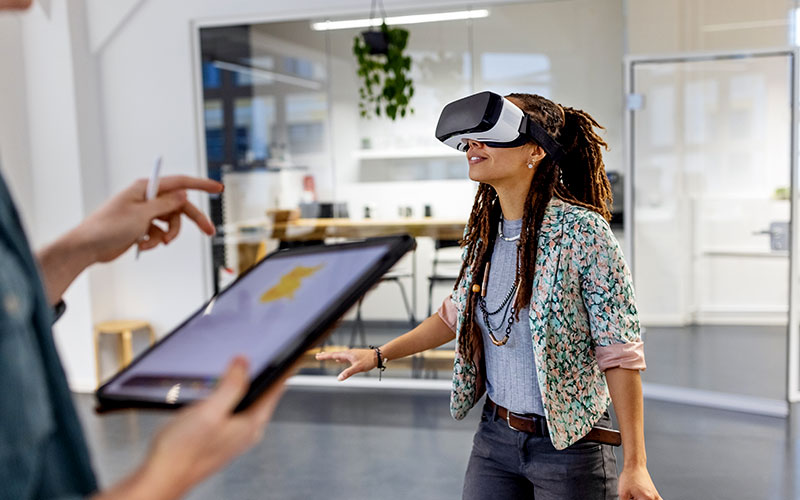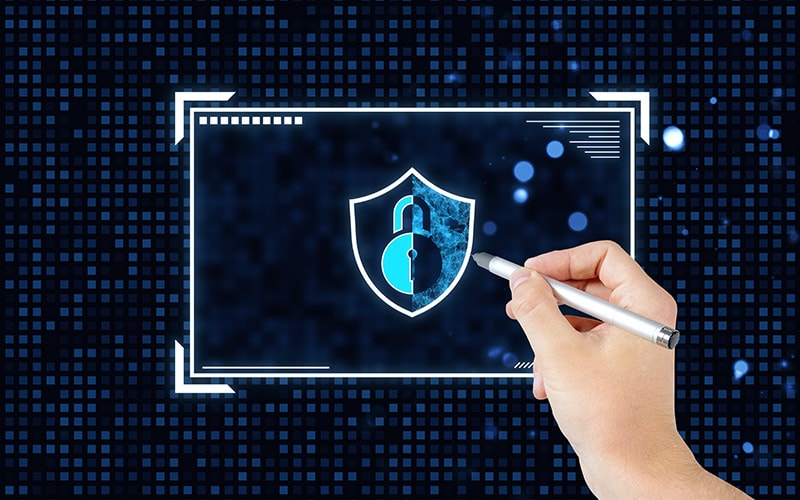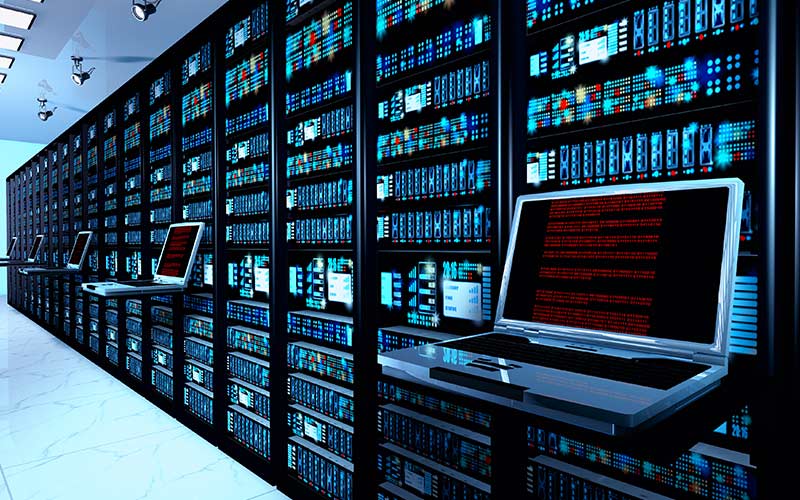Insights
- Enterprises across businesses are collaborating to create a metaverse ecosystem, where people and organizations can interact, work, socialize, entertain, and transact with each other.
- The global metaverse market is expected to grow from $107.1 billion in 2020 to $758.6 billion by 2026 — driven by applications offering workforce collaboration, product design and development, manufacturing, logistics, sales and marketing, and retail.
- This ecosystem will have three core layers — connectivity, computing, and application — supported by other enablers and system integrators operating under an overarching framework of secure and sustainable technology.
- While each player will have space to contribute to this ecosystem, large tech companies will continue leading developments.
According to Microsoft, a metaverse is a space populated by digital representations of people, places, and things.1 It’s a vision of an immersive internet where one’s 3D digital representation can communicate, share, work, and play with those of other people and machines. Many such digital worlds will be created, and most of them will be interoperable and connected, forming many metaverses. These digital spaces will be based on the fundamentals of Web 3.0, which calls for decentralization and trustless, permissionless ubiquitous connectivity.
Companies and technologies from all spheres will need to come together to build an ecosystem where people and businesses can interact, work, socialize, entertain, and transact with each other. They will also need to address issues around data privacy, personal identity, user safety, network and platform security, ethics, financial fraud, and other such challenges.
The metaverse ecosystem is growing rapidly, with many companies across industries vying for a share by delivering innovative experiences through several exploratory developments. However, it is still in its infancy, and the formation of well-defined economies will take its due course as the different approaches of various stakeholders start to align. Nonetheless, the current developments on both the business and technology sides give us an indication of where things are headed.
The metaverse vision
The global metaverse market is expected to grow to $758.6 billion by 2026 from $107.1 billion in 2020.2 This growth will come from applications in the space of workforce collaboration, product design and development, manufacturing, logistics, sales and marketing, and retail. We expect governments to leverage the metaverse to build ways to deliver social services. South Korea is already working on enabling virtual tourism, filing of civil complaints, and other services in the metaverse ecosystem.3
Physical and online video games are set to be worth $219 billion by 2024, and they will be increasingly immersive and collaborative
The gaming industry has traditionally led advancements in virtual worlds, and the metaverse is the industry’s latest charm. The global video game market — covering consumer spending on physical and digital video games across devices, and online gaming subscriptions — is expected to grow at a 6.7% average annual rate to reach $218.8 billion in 2024 from $180.3 billion in 2021.4 Gamers are already using 3D avatars, trading digital assets, spending money at virtual casinos, immersing themselves in community streaming, and attending in-game virtual concerts. In April 2020, for example, rapper Travis Scott performed a concert in Fortnite, the immersive game world, that was watched by up to 12 million participants.
We expect a greater emphasis on building communities in these game worlds and solving real-world problems, with gamers getting paid for their exploits through non-fungible tokens (NFTs). While immersive gaming is based in discrete virtual worlds presently, growing decentralization could push them to open up and increase interoperability.
Workspace collaboration is expected to be a major area for innovation, given the permanent shifts brought by the pandemic. Microsoft is rolling out Mesh for Microsoft Teams, which allows people to collaborate using customized avatars (or their digital twins) in mixed reality.5 It also allows organizations to build their own virtual spaces. Onboarding new hires, conducting town halls in mixed reality, and using virtual whiteboards and screens to further improve productivity in remote working are just a few of the possibilities with Mesh.
In manufacturing, BMW has created a digital twin of one of its German factories using NVIDIA’s Omniverse, which comprises a set of platforms for building 3D virtual environments.6 The company can bring together people from around the globe in order to design and plan the factory in real time. It also uses avatars and robotics to simulate factory floor operations to test new workflows and identify areas of improvement in efficiency, quality assurance, and input costs. We expect digital twins of factories to become testing grounds for innovation — accelerating product design, development, and go-to-market processes.
Retail giants, including Nike, Adidas, and Walmart, have started rolling out digital products within the metaverse through NFTs. In December 2021, Adidas earned approximately $22 million in one day by launching NFTs for sale, which included access to hoodies and shoes with digital characters such as the “Bored Ape” collection.7 Walmart is also reportedly exploring the metaverse and considering launching its own cryptocurrency and NFTs.8 The consumer-focused industries will also witness the creation of virtual 3D spaces for several core experiences such as trying on wearables, checking out holiday destinations, and taking tours of real estate properties.

The metaverse ecosystem and the battles within
This metaverse vision will be realized through the convergence of several fast-evolving technologies, including spatial computing, cloud continuum and edge computing, augmented reality (AR) and virtual reality (VR), 5G/6G networks, the internet of things (IoT), blockchain, artificial intelligence (AI), and head-mounted displays or other sensory devices.
The core metaverse ecosystem comprises of connectivity, computing, and application layers, which are supported by other enablers and system integrators operating under an overarching framework of secure and sustainable technology
The current players in the metaverse come under three major layers: connectivity, cloud and edge computing, and applications (Figure 1). In addition, there are key enablers that perform niche tasks and system integrators that stitch together offerings and platforms for custom use cases. Lastly, security, sustainability, AI, and blockchain need to be incorporated across all these elements.
Layer 1: Connectivity
For the metaverse to really take off, enterprises and consumers will require ultrafast, reliable, low-latency networks. Investments in fiber-optic cables, 5G/6G, edge connectivity, and satellite networks will make it all possible.
We expect telcos’ dominance and control over mobile network infrastructure to reduce, with decentralized providers stepping up. Helium is one such crowdsourced network built by individuals who invest in a device that acts as a public hot spot.9 These people get rewarded in crypto tokens that can be converted into real money through crypto exchanges. Such networks are built on unlicensed bands of radio frequencies that support low-power applications and are expected to play a major role in connecting sensors or IoT devices to facilitate real-time data transfer.
Satellite networks being created by companies such as SpaceX, Amazon, and OneWeb are also going to penetrate deeper into broadband services. These companies are placing thousands of satellites in low-Earth orbit to provide reliable internet connectivity to the remotest parts of the planet. In the future, these networks could also support the global connectivity requirements of the metaverse. These companies are also partnering with telecom players to deliver wider internet connectivity around the globe instead of competing with them in the same territories.10, 11
Layer 2: Cloud and edge computing
The real-time, immersive experience of the metaverse will depend on the immense computing power of the cloud. Hyperscalers such as Amazon, Google, Facebook, and Microsoft are cash rich with a strong presence in computing power, applications (or content platforms), and user experience devices. They also possess massive amounts of user data and are pioneering developments in AI and automation.
These players are already making big moves to stake their claims: Facebook has rebranded itself as Meta and pledged to spend $10 billion on its metaverse ambitions in 2021 alone.12 Microsoft has acquired the gaming company Activision Blizzard for $68.7 billion to lay down its metaverse foundations.13
While these companies are staking their claims, cloud computing is increasingly becoming environmentally unsustainable — primarily due to an exponential growth in AI applications. This in turn is driving the shift toward edge computing and tiny AI concepts that require less data and computing power. Here, computing is done much closer to the end user and often on the device itself rather than in the cloud, which in turn reduces power consumption and latency. That said, metaverse experiences are more reliable and sustainable than if everything has to be shunted to the cloud for processing.14
Hyperscalers will have to pay attention to the shift toward sustainability in cloud and edge computing to maintain their dominance.
Layer 3: Applications
This is where users come to experience 3D content, from games and social networks to workplace collaboration. In the future, this will add digital twin spaces and users for industry, education, and entertainment.
Gaming companies appear to be doing well in this space. These providers have traditionally led the virtual worlds and are now nimbly adapting.
We expect big incumbents in gaming and social media to continue dominating. We already know that new social networks are unlikely to disrupt the existing big players — Facebook, Instagram, Twitter, and TikTok. This poses a challenge for new entrants to convince people to switch to their networks.
Key metaverse enablers
3D content development engines
Third parties will use low-code/no-code tools to build their own components in these bigger spaces, ranging from games to social, educational, and entertainment offerings. These tools will also allow people to create their own 3D avatars; for example, if someone is attending an event in the metaverse, she can use available tools to design a customized avatar that processes and renders movements and expressions in real time.
User experience devices and chipsets
Hardware — comprising the kit for users, such as VR headsets and AR glasses, and the chipsets that drive consumer devices and the infrastructure — is crucial for the metaverse.
User devices have yet to be widely adopted. This is partly to do with the cost of the kit as well as a lack of quality content. It also involves issues such as user nausea. However, work is underway to address these issues.
Existing big players, including Microsoft and Meta, already offer high-end AR and VR devices, while Apple is rumored to be working on its own headsets. And there are hundreds of startups, such as Lux Labs, Displex, Mirraviz, and Yes AR, working on devices. But we expect cash-rich incumbents to fare better in this space given their ability to experiment and iterate as they develop their devices.
The kit, from user hardware to infrastructure, requires chipsets. And big chipmakers such as Qualcomm, AMD, Intel, and NVIDIA are investing in this space. For instance, Qualcomm has collaborated with Microsoft to make custom chips for AR glasses,15 and AMD is developing data center chips for Meta’s metaverse ambitions.16
Digital finance and regulations
The digital economy in the metaverse requires a financial framework that functions across different spaces. Currently, cryptocurrencies such as Ethereum are widely used for trading digital art, land, and other assets. From April to June 2021, the Ethereum blockchain recorded transactions (comprising trading and lending payments) worth $2.5 trillion, accounting for the bulk of global decentralized finance (DeFi) activity.17 The metaverse will provide a much bigger ecosystem for such DeFi activities.
However, national and financial authorities are concerned about the lack of regulation. Scrutiny and regulatory oversight should increase to curb scams and crime. Nonetheless, some level of finance decentralization and automation will be required if various metaverses are to work together.
System integrators will stitch it all together
With the vastness of the metaverse ecosystem, no single organization will be able to do it all. This is where system integrators (SIs) come into the picture to stitch together various technology offerings from multiple providers and build a customized and connected system. These companies will manage, maintain, and support other players in the ecosystem, and will help improve interoperability.
For instance, SIs will help organizations build and connect customized digital twins, workforce collaboration tools, local social networks, and other features on top of the standard tools and platforms provided by 3D content platforms and engines .
These technologies will include geospatial mapping, voice/gesture recognition (using AI and natural language processing), data integration with IoT devices, intuitive user interfaces, avatars and digital assets, virtual stores, and smart contract platforms. SIs will also help incorporate security and privacy into these applications. They will assist in the orchestration of the metaverse infrastructure. For example, SIs’ role in scaling cloud computing and edge capabilities will drive real-time interactions. They are already driving enterprise-wide adoption of blockchain-based commercial models across industries.
The more complex this ecosystem becomes, the more opportunities it will create for SIs.
In February, Infosys announced the launch of its Metaverse Foundry, which is a digital innovation unit aimed at helping enterprises explore metaverse opportunities with Infosys platforms and ready-to-apply use cases and templates.18
Secure and sustainable AI and blockchain to be incorporated across the ecosystem
New technologies also mean novel and increased security threats. The reputations of companies will depend on how secure they are: Secure digital identities, assets, transactions, and applications will be paramount to ensure safe interactions in the metaverse. With AI, preventing the misuse of deep fakes could be challenging, as with more advancements it will become nearly impossible to know whether there is actually a human behind a metaverse’s digital human or just an AI algorithm.
We recommend zero-trust security right from the start: from conceptualization and design of hardware, applications, and networks to their deployment and maintenance. Such practices are necessary to prevent identity theft, data hacks, selling of fake NFTs, malicious smart contracts, hacking of AR/VR devices, and many other such challenges. Avatars and other digital identities will have to be as reliable and secure as a passport or a Social Security number.
Blockchain, which is expected to be the primary enabler of decentralization in the metaverse, facilitates smart contracts that allow automatic assignment, verification, and transfer of ownership, in addition to NFTs. It is expected to make financial transactions faster, cheaper, and more transparent through DeFi applications. However, the buzz around NFTs and cryptocurrencies is making it harder to separate the noise from actual value-creating applications. Thousands of crypto tokens are already trading on exchanges, but the future will likely not be bright for many of them.
Sustainability is another core challenge. At present, AI already has a carbon footprint greater than the airline industry, and the growth of these technologies threatens to make this worse.19 We must also consider the potential huge growth in e-waste if metaverse hardware takes the same path as smartphones, tablets, and personal computers.
While companies like Meta and Microsoft have promised net-zero emissions, others will take time in this vast ecosystem to get to this point. Governments and enterprises need to clearly define the requirements and initiatives for sustainable growth of the metaverse, as the current, largely self-governing structure won’t be enough.

Who will win the metaverse?
The metaverse is about building an interconnected ecosystem. With multiple stakeholders and users operating in this space, competition and cooperation will need to coexist. The big technology players will develop their own product ecosystems, but they will also need smaller players to enhance experiences and services. For example, Meta might create a social network where people interact as avatars. Still, it may not be able to provide sufficient customization to its 3 billion users without the help of other players in this domain. To enable that, it can allow users to create avatars elsewhere and integrate them into Facebook or partner with specialized avatar creation companies to host platforms within its platforms. Such partnership opportunities will make space for many kinds of companies in the ecosystem. Some will assist with ethical AI capabilities (e.g., Synthesis AI), while others will create peer-to-peer marketplaces (e.g., OpenSea) and design VR games aimed at solving cognitive disorders (e.g., Virtuleap).20
Tech companies will continue to control a major chunk of the metaverse, but there’s enough room for innovative companies to win in this vast ecosystem
However, it is unlikely that the status quo will change soon. The bulk of profits will still land in the pockets of these large technology players building comprehensive metaverse ecosystems with closed walls but better experiences. This is because they possess the power to make it happen, and users can only spend a limited amount of time across a few virtual environments. Similarly, telcos will form an integral part of the ecosystem. But they may continue to act as dumb pipes unless they evolve their business models in the new paradigm.
The content creation and delivery space will see immense innovation and competition, as it will only be limited by human imagination. Digital twins of theaters, studios, meeting rooms, and other such environments will provide near-to-reality experiences. For example, in 2021, British auction house Sotheby’s held a digital art auction at a digital twin of its London headquarters.21 In addition, there are apps such as Melon.ooo that help users convert their social media posts (text or audiovisual) into NFTs and Meta’s Polar that allows users to create AR objects and effects without any coding.
Numerous such companies will continue to spring up and incrementally make the metaverse ecosystem bigger. It appears there is enough space for anyone creating real value for enterprises and consumers. There is a lot of hype around digital assets and cryptocurrencies, but it will gradually fade away and use cases with real economic potential will emerge — revealing the winners behind them as well.
References
- Mesh for Microsoft Teams aims to make collaboration in the ‘metaverse’ personal and fun, John Roach, Nov. 2, 2022, Microsoft.
- Global Metaverse Market Research Report 2022, March 1, 2022, Business Wire.
- South Korean government to make Seoul a metaverse city by Dec 2022, Ishika Yadav, Nov. 12, 2021, TechGig.
- The Games Market and Beyond in 2021: The Year in Numbers, Tom Wijman, Dec. 22, 2021, newzoo.
- Mesh for Microsoft Teams aims to make collaboration in the ‘metaverse’ personal and fun, John Roach, Nov. 2, 2022, Microsoft.
- BMW uses Nvidia’s Omniverse to build state-of-the-art factories, Louis Columbus, Nov. 16, 2021, VentureBeat.
- Adidas sold more than $22 million in NFTs, but it hit a few snags along the way, Jay Peters, Dec. 17, 2021, The Verge.
- Walmart is quietly preparing to enter the metaverse, Lauren Thomas, Jan. 16, 2022, CNBC.
- Tiny AI for a Sustainable Digital Future, Rajeshwari Ganesan, Jitesh Gera, Harry Keir Hughes, et al., Nov. 2021, Infosys.
- Musk’s SpaceX readying to collaborate with Indian telcos for satcom services, Danish Khan, Nov. 3, 2021, The Economic Times.
- OneWeb won’t compete with telcos but collaborate with them: Sunil Mittal, Sept. 8, 2021, The Economic Times.
- Facebook Expects Metaverse Project Will Cost At Least $10 Billion — In 2021 Alone, Abraham Brown, Oct. 25, 2021, Forbes.
- Microsoft to acquire Activision Blizzard to bring the joy and community of gaming to everyone, across every device, Jan. 18, 2022, Microsoft.
- Tiny AI for a Sustainable Digital Future, Rajeshwari Ganesan, Jitesh Gera, Harry Keir Hughes, et al., Nov. 2021, Infosys.
- Qualcomm, Microsoft tie-up to make metaverse chipset for AR glasses, Ishika Yadav, Jan. 6, 2022, TechGig.
- AMD Has Won Meta As Its Data Centre Chip Customer For Creating Metaverse, Ratnesh Shinde, Nov. 9, 2021, Technotification.
- Adventures in DeFi-land, Sept. 18, 2021, The Economist.
- Launching Infosys Metaverse Foundry: Service to Accelerate Enterprises’ Ability to Evolve and Execute Strategies for Virtual-Physical Interconnections, Feb. 24, 2022, Infosys.
- Deploying artificial intelligence at the edge: Key takeaways from SEMI CTO Forum, Dr. Pushkar P. Apte and Tom Salmon, Sept. 13, 2021, SEMI.
- 15 Disruptive Companies Making Their Mark in The Metaverse Future, Nov. 22, 2021, Deeptech Insider.
- The Metaverse Will Radically Change Content Creation Forever, Falon Fatemi, March 7, 2022, Forbes.






